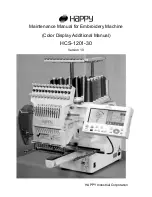
– 54 –
9. TROUBLES AND CORRECTIVE MEASURES
TROUBLES
CAUSES
CORRECTIVE MEASURES
1. Thread breakage
(Thread is untwisted
or scraped.)
(Needle thread 2 to
3 cm is left on the
wrong side of the
fabric.)
(Bobbin thread
comes out of the
bobbin.)
①
There is a sharp edge or burr on
the thread path, needle point, hook
blade point or bobbin case resting
groove on the throat plate.
②
Needle thread tension is too high.
③
Bobbin case opening lever
provides an excessive clearance
at the bobbin case.
④
Hook blade point hits the needle.
⑤
Hook is not lubricated properly.
⑥
Needle thread tension is too low.
⑦
Thread take-up spring is too tight
and its stroke is too small.
⑧
Needle-to-hook timing is wrong.
⑨
Thread untwines.
⑩
Uniform thread loops cannot be
formed when making chain-off
thread.
⑪
Bobbin is wound with excessive
amount of thread. (In particular,
filament thread)
◦
Remove sharp edge or burr using a fine
sandpaper. Polish the surface of the
bobbin case resting groove on the throat
plate using a buffing wheel.
◦
Adjust the needle thread tension.
◦
Reduce the clearance.
"6-5. Adjusting the inner hook
.)
◦
Refer to
"4-17. Needle-to-hook relation"
.
◦
Increase the amount of oil supplied to the
amount of oil in the hook" p.9
.
◦
Adjust the needle thread tension.
◦
Reduce the tension of the spring and
increase the stroke.
◦
Refer to
"4-17. Needle-to-hook relation"
.
◦
Wind the thread on the
needle.
◦
Use the thread guide equipped with felt
pad.
◦
Use the optional needle clamp wire.
◦
Wind the bobbin with thread by 80 % of its
capacity.
2. Stitch skipping
①
Clearance between the needle and
the hook blade point is too great.
②
Needle-to-hook relation is wrong.
③
Pressing force of the presser foot
is not enough.
④
Needle bar height is wrong.
⑤
Needles are a little too thin.
⑥
Synthetic thread or thin thread is
used.
⑦
Stitch skipping occurs at the
beginning of sewing.
⑧
Stitch skips when sewing
multilayered parts of the material.
⑨
Stitch skipping occurs when the
material thickness changes, i.e.,
from a two-ply part to a multi-
layered part and vice versa.
◦
Refer to
"4-17. Needle-to-hook relation"
.
◦
Refer to
"4-17. Needle-to-hook relation"
.
◦
Tighten the presser spring regulator.
◦
Refer to
"4-17. Needle-to-hook relation"
.
◦
Replace the needle by thicker ones.
◦
Wind the thread on the needle.
◦
Use the optional needle clamp wire.
◦
Run the sewing machine under the soft
start mode by 2 to 3 stitches from the
sewing start.
◦
Use the needle thread guide and precisely
adjust the hook timing.
◦
Move the presser foot toward the operator.
At this time, be careful not to allow the
presser foot to come in contact with the
needle.



































